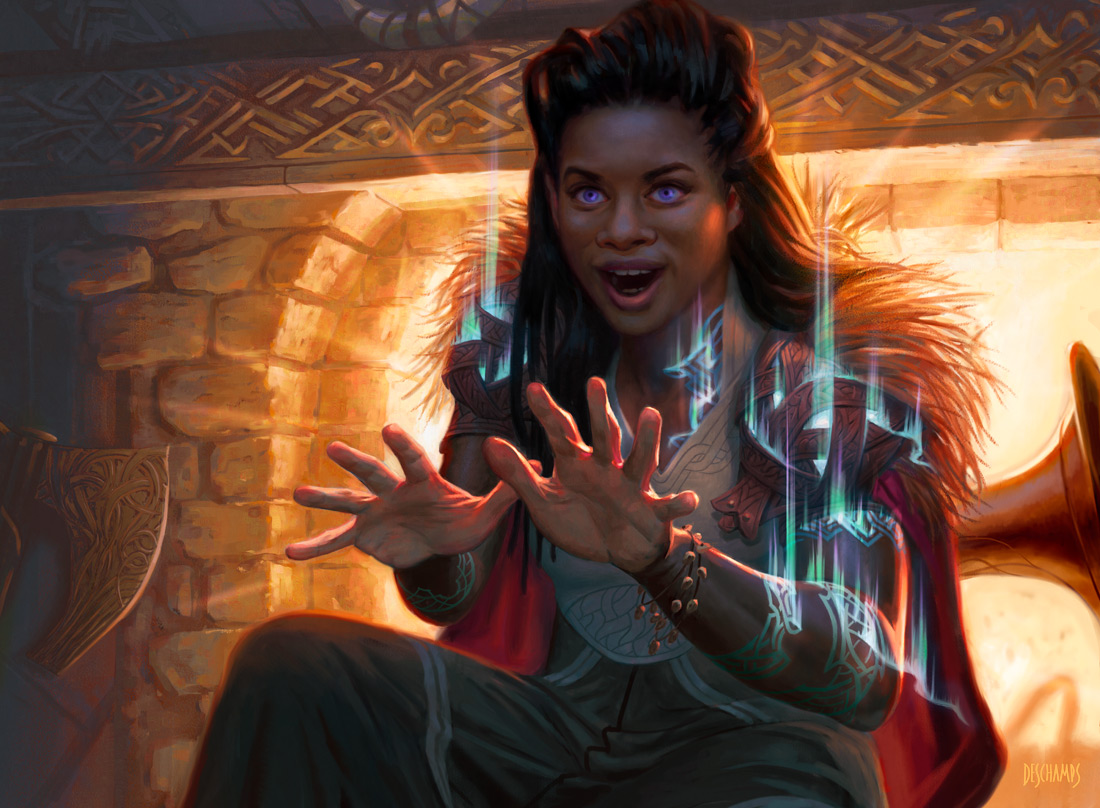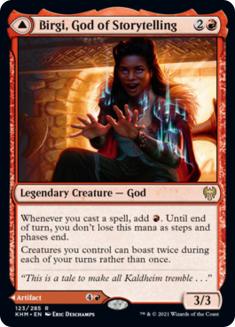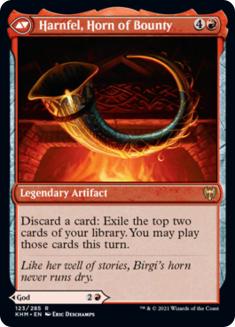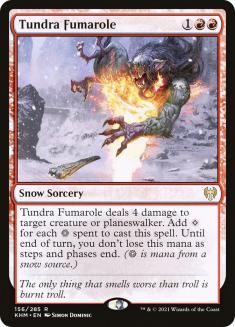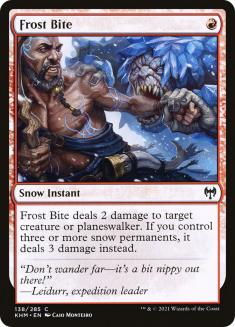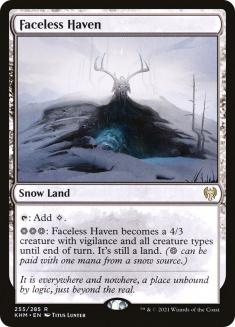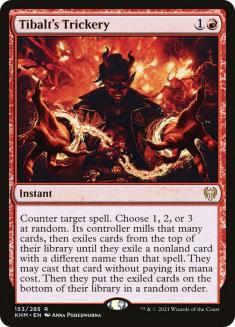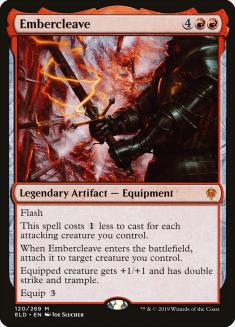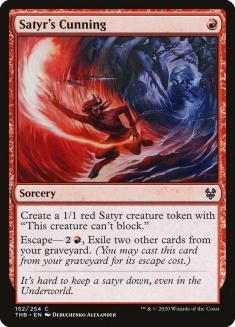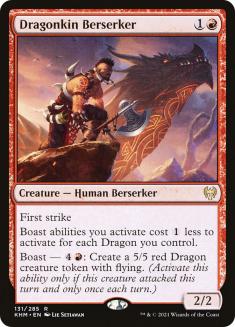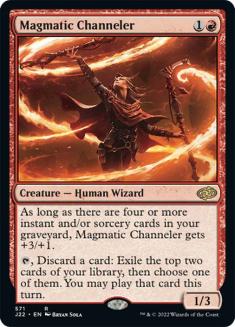It’s Christmas time for content creators. The three weeks leading up to a new set release are always fun because we get to flex our creative muscles. We’re close to the release of Kaldheim, and with the new set also come new ideas, new decks, and revivals of old archetypes thanks to new cards. I’m hoping that today’s article will help reinvigorate Mono-Red Aggro, an archetype that has largely been supplanted by Gruul Adventures. The release of Kaldheim means we’re getting a lot of new toys to work with, but will they be enough to justify sticking to one color?
If playing Magic for so long has taught me anything in the past, it’s that mono-color decks are the ones that can most effectively take advantage of the snow mechanic because they get to play the most snow lands without any real punishment. In older formats, you can use the fetchlands to find your snow basics, so playing more than one or two colors is much easier to do while maintaining a high snow count. I figured if we’re going to try out snow in an aggro shell, Mono-Red might be the spot! Let’s get down to business.
Creatures (24)
- 4 Robber of the Rich
- 4 Fervent Champion
- 4 Bonecrusher Giant
- 2 Torbran, Thane of Red Fell
- 2 Rimrock Knight
- 4 Anax, Hardened in the Forge
- 4 Birgi, God of Storytelling
Lands (22)
Spells (14)
Sideboard

I’ve had one card and one card only on my mind for the last few days.
A few weeks ago, someone on Twitter said that Birgi, God of Storytelling is like Runaway Steam-Kin and Experimental Frenzy rolled into one. Side by side, they’re two great cards that could make the grade in a slower Standard format. Together, you get a versatile tool that can take over the game in two different forms via two different cards. The legendary status isn’t really a downside either since you can just cast the backside when you draw redundant copies. The front side is dangerous enough to warrant immediate removal too, so I expect drawing two or three copies will rarely, if ever, be that bad.
Birgi lets you cast all your cheap cards for free, but the true strength comes from a virtual one-less casting cost on every spell you cast. When your deck is chock-full of split cards, DFCs, and Adventures, having them all cost one less means you can occasionally gain two mana on a single card. That mana doesn’t leave until the end of the turn either, which means you have a shot at casting Embercleave with that floating mana too.
The boast booster isn’t all that relevant in this archetype, but I’ve been toying with a few decklists that put it to good use. I’ll definitely need to play with some of the boast cards before I decide if they deserve a slot. They all seem “fine” but none of them really stand out as particularly broken except maybe Dragonkin Berserker, but it’s relatively expensive to get going.
The back half of Birgi is Harnfel, Horn of Bounty, a card that doesn’t necessarily “fit” into most aggressive red shells, but the lasting impression of Experimental Frenzy has me double-checking every single one of these engine-type cards. The selective nature of discarding extra lands or dead removal spells to find more impactful threats or answers makes Harnfel pretty terrifying to play against. It means you’ll rarely end the turn without doing something phenomenal and your dead draws aren’t so dead anymore.
Harnfel being the backside of Birgi means drawing two and casting them in conjunction with one another can lead to some astounding turns. Against a midrange or control opponent, or anyone trying to grind you out via resource denial, Harnfel should help you push through the attrition war. In some matchups, the mana boost and efficient body from Birgi is desirable. In other matchups, the only card you want to draw and cast is Harnfel. I spent a lot of time in Standard during the Runaway Steam-Kin Red era grinding ladder. Against control or midrange, having an engine that keeps the little creatures and burn spells coming is huge.
The one area I’ve thought current Mono-Red Aggro decks struggled in was the late-game. Embercleave is obviously powerful, and Anax, Hardened in the Forge gives you some staying power in the face of removal, but winning a game that takes longer than seven or so turns seemed impossible before now. I legitimately think Harnfel could be the next Experimental Frenzy and it just so happens to be printed on a Runaway Steam-Kin.
Tundra Fumarole is a bit weird in the archetype, but I felt like it might actually be absurd with exactly Harnfel. Killing a creature and gaining some mana back is a huge deal, but the problem comes with trying to spend colorless mana. Red decks are known for being intensive on red over colorless mana, since they’re usually chock-full of cheap cards, and those cheap cards just have more colored requirements on average.
This deck, like Chonky Red in Pioneer, has a few cards (and other ways) to utilize colorless mana. Bonecrusher Giant has a lot of colorless mana on the card, so a single Tundra Fumarole can lead to an absolute banger turn. Alongside Birgi on the battlefield, you should be able to generate the red and colorless necessary to cast most spells when you resolve a Tundra Fumarole. I’m trying to utilize this one game concept that has been relatively lost in Magic over the last few years. You might have heard me mention it once or twice: synergy.
Red decks traditionally have trouble killing creatures with four or more toughness. In order to get to the breaking point to kill a creature with four toughness, you often need a spell that costs three or more mana. Soul Sear in the sideboard is a great example of this, but Tundra Fumarole is special because it allows for a bit more velocity-building than something like Char or Exquisite Firecraft.
The downside, of course, is that Tundra Fumarole can’t target players. It’s strictly a removal spell for creatures and planeswalkers, but I feel like the texture of Standard has moved in that direction a lot over the last few months. Having dedicated removal in red decks that doesn’t hit players feels pretty bad, but we gotta take what we can get.
Spells that generate mana when you cast them usually deserve a second glance. My first peek at Tundra Fumarole led me to believe that it would be fine, but further inspection makes it feel like it deserves a lot more consideration. Will it end up being the Burning-Tree Emissary of this Standard format? That mana boost being colorless is obviously a downside, but I feel like we can find ways to use that mana. Building around Tundra Fumarole and Birgi might be the new direction for Mono-Red. I love me a bigger red deck anyway, so anything to justify moving in that direction will find no resistance from me.
I’m not confident this one is better than Shock because it can’t hit players, but being able to kill a three-toughness creature for one mana is pretty absurd. Almost all the one-mana spells that deal three or more damage to a creature without a significant drawback have seen Standard play at one time or another. Lightning Bolt was always excellent because it was the most efficient burn spell of all time and had zero restrictions on the target.
Frost Bite isn’t Lightning Bolt. It’s more like Fiery Impulse, but that was certainly a solid card in Standard while it was around. Skred dealing four or more damage to a creature was always busted, but I don’t think we’ll get Skred or anything like it in Standard ever again.
I think it’s important to have cheap removal spells, and cheap spells in general, when you’re building around Birgi. One of the more powerful strings has to include Birgi and a host of one-mana plays. Frost Bite might be better as an additional Shock as opposed to becoming the new normal, but the only way we can figure that out is if we get some reps in with the card! I’m always excited about a Shock variant that can kill larger creatures. The downside of Shock has always been the diminishing returns against opponents with larger creatures and a high life total.
I love Faceless Haven. I would also love to play four copies but that would likely require cutting Torbran, Thane of Red Fell completely. In Pioneer, I often shaved on Torbran to fit four copies of Mutavault into Chonky Red, so the numbers will likely need to be tweaked, but that just comes with time and testing. What I do know is that Faceless Haven will be a mainstay in Standard for some time. It’s the perfect land for most monocolored aggro decks, though it suffers a little bit from the DFCs not tapping for snow. It’s relatively snow-mana-intensive, needing three pips in order to activate, but it hits extremely hard and is relatively efficient when it comes to raw mana usage.
The light snow splash in these Mono-Red decks is giving me tingles. Faceless Haven is likely good enough on its own to justify playing Snow-Covered Mountains. One or two feels almost free, even if you play no other snow-matters cards, because having access to a land that puts that much pressure on the opponent or their planeswalkers is ridiculous. I don’t know how good Tundra Fumarole or Frost Bite are, but that will assuredly wax and wane based on how many creature-based strategies exist in the format. Assuming Doomskar doesn’t change the format dramatically, I think both will be quite good.
Faceless Haven can allow for aggro decks to survive an onslaught of Doomskar. Getting around the hot new sweeper in Standard will be immensely important, so having multiple avenues of defense against it is big. Both Faceless Haven and Harnfel allow an otherwise normal aggressive deck to make a comeback in the face of such powerful interaction. Like a cheap planeswalker with a big effect, these two cards sidestep Doomskar and allow red to play a longer game. Without them, I don’t think this style of deck can flourish.
Tibalt’s Trickery is my one-card answer to Doomskar (or any other sweeper). The goal is to hinder the opponent by countering their one spell that matters and give them a free spell that hopefully doesn’t matter. I don’t know for sure if this card is actually good. It’s random and involves some elements that are foreign to red decks in general, but I adore sideboard cards that solve weird problems, even if they aren’t exactly reliable.
The good news is that whatever card you tag with Tibalt’s Trickery will be countered. The bad news is that it won’t be very good against a deck full of spot removal or archetypes with a lot of redundancy. I want to put an emphasis here on why I’m choosing Tibalt’s Trickery because I don’t want you to sideboard it in against matchups where it will be weak. I’d much rather you never use it than bring it in against an opponent where it will have negative effects.
If your opponent is playing a combo deck, a control deck, or a weird brew with one or two cards that actually matter and a bunch of stuff that doesn’t, there’s a good chance that Tibalt’s Trickery will be a knockout punch. It’s like a bad Arcane Denial, but in a color that rarely gets a tool like this.
Game Theory and the Advancement of Red
The future of aggro is up in the air because these new tools allow for a lot of customization inside of the archetype. Moving to a more midrange version might be the play, but having a lower overall curve for Birgi makes a ton of sense. You want to get the most use out of all your cards in as many ways as possible, but that might directly conflict with the base principles of red in the current environment.
My biggest giddy moment with this deck came from discovering how powerful Tundra Fumarole is with both sides of Birgi. Getting the red mana to cast another spell or just generating a ton of colorless mana to cast Harnfel, effectively making the Tundra Fumarole free, just seemed too strong to pass up.
Here’s the rub: I don’t know if this is an Embercleave deck anymore. I don’t know if we should move away from all the things that have made Mono-Red Aggro what it is over the past year. Anax, Hardened in the Forge and Embercleave seem like such important cards to the archetype until you realize that they make interacting with the opponent extremely mediocre. If you want to kill your opponent’s creatures, you probably shouldn’t be all-in on Embercleave.
The broken nature of Experimental Frenzy was primarily based around your ability to end the game quickly with burn spells off the top. Turning those extra cards into actionable game pieces was a huge deal, but they were all so cheap and relatively weak in comparison to your opponent’s pieces that you needed a ton of raw spells cast to actually make Experimental Frenzy worthwhile. Lightning Strike and Wizard’s Lightning were perfect for the archetype, as they could be cast without a creature to target, clearing the top of your deck and/or fueling Runaway Steam-Kin.
Over the past year and change, Embercleave has been the primary reason to play red in Standard, but that’s only because there weren’t any cards powerful enough to justify a different direction. Assuming you’re sticking to Mono-Red, few cards can match Embercleave in power level compared to what other colors/archetypes have access to.
I believe Birgi could be the card that gives us a different way to build Mono-Red. Even if we aren’t necessarily as aggressive as the Embercleave decks, that doesn’t mean much so long as we are winning games. If our cards all working together generate enough synergy and we can roll that into a distinct advantage, getting Embercleave (and some of the other weak enablers) out of the deck could be a huge step for improving the Birgi builds.
Here’s a rudimentary build showcasing what things could be like without Embercleave.
Creatures (19)
- 4 Bonecrusher Giant
- 3 Torbran, Thane of Red Fell
- 4 Magmatic Channeler
- 4 Dragonkin Berserker
- 4 Birgi, God of Storytelling
Lands (22)
Spells (19)

This is a very rough draft, but I’m trying out a lot of different cards to see how they mesh. Birgi and Harnfel are extremely hard to evaluate without actually playing with them. If we’re going to take the leap and move away from Embercleave, we have to try anything and everything to help that come to fruition, including this forgotten gem:
One way to guarantee you gain a significant amount of mana from Birgi is a spell that can be cast multiple times. Escape is a great mechanic for helping do just that, and Satyr’s Cunning just so happens to be an absolute heater when paired up with Torbran. While they’re not exactly defensive because the tokens can’t block, Satyr’s Cunning allows you to generate a ton of creatures / permanents / threats for a very small investment.
My first instinct with Birgi was to look for all the cheap red spells. Satyr’s Cunning, while weak when cast alone, is quite spectacular when cast over and over again. Giving your deck more ways to utilize mana from Birgi and Tundra Fumarole is important for generating enough synergy to oust Embercleave as our go-to gameplan.
This one having first strike is actually pretty sick because it means it might actually play defense well. It also gives you another mana sink, which is great for playing so many lands, playing longer games, and giving you a way to use the extra colorless mana from Tundra Fumarole.
For the most part, this whole article is a deckbuilding exercise to see if we can push the free mana from Tundra Fumarole to the limit. Just looking at how these cards interact and estimating their effect when working together is important for analyzing the new set.
Magmatic Channeler is another heater that hasn’t gotten nearly enough attention in Standard, and that is mostly thanks to the existence of Embercleave. This build focuses on putting a lot of cards into your graveyard via casting cheap interaction. If you’re successful in that interaction, following it up with a Magmatic Channeler could help dominate the battlefield defensively while generating some card economy along the way.
The terms “red” and “defensive” don’t often go together, but Magmatic Channeler is actually one of the better defensive cards for a red deck like this. A cheap 4/4 body in the mid-game can generate some real problems for Gruul Adventures, as just trading with Questing Beast might end up being the nuts.
Against opponents where you don’t necessarily want to engage in combat, Magmatic Channeler can start by generating some resources without much effort. It will eventually fuel itself, and ultimately become a 4/4 beater, but the early turns are for development. Casting this on the second turn instead of interacting with your opponent’s creature(s) will be a major focal point for the gameplay, as well as a litmus test on whether or not Magmatic Channeler is worth the investment.
It will take a lot for this rag-tag group to overtake the raw power and ease of victory that Embercleave generates. I’d wager Embercleave plus Anax has ended more careers than Damian Lillard, so any argument for removing them from your Mono-Red Standard deck needs to be thoroughly vetted. When the set is released on Magic Arena later this week, Mono-Red in all forms will be at the top of my testing list.
Until then, assume Embercleave isn’t going anywhere anytime soon, but don’t be afraid to try out some new stuff! The only reason Embercleave is so prominent in red decks is because it’s good. In order to supplant Embercleave as the better red strategy, we’ll have to do a lot of work, but I’m up for the challenge!

